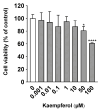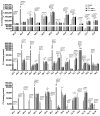Kaempferol Improves Cardiolipin and ATP in Hepatic Cells: A Cellular Model Perspective in the Context of Metabolic Dysfunction-Associated Steatotic Liver Disease
- PMID: 38398832
- PMCID: PMC10892986
- DOI: 10.3390/nu16040508
Kaempferol Improves Cardiolipin and ATP in Hepatic Cells: A Cellular Model Perspective in the Context of Metabolic Dysfunction-Associated Steatotic Liver Disease
Abstract
Targeting mitochondrial function is a promising approach to prevent metabolic dysfunction-associated steatotic liver disease (MASLD). Cardiolipin (CL) is a unique lipid comprising four fatty acyl chains localized in the mitochondrial inner membrane. CL is a crucial phospholipid in mitochondrial function, and MASLD exhibits CL-related anomalies. Kaempferol (KMP), a natural flavonoid, has hepatoprotective and mitochondrial function-improving effects; however, its influence on CL metabolism in fatty liver conditions is unknown. In this study, we investigated the effects of KMP on mitochondrial function, focusing on CL metabolism in a fatty liver cell model (linoleic-acid-loaded C3A cell). KMP promoted mitochondrial respiratory functions such as ATP production, basal respiration, and proton leak. KMP also increased the gene expression levels of CPT1A and PPARGC1A, which are involved in mitochondrial β-oxidation. Comprehensive quantification of CL species and related molecules via liquid chromatography/mass spectrometry showed that KMP increased not only total CL content but also CL72:8, which strongly favors ATP production. Furthermore, KMP improved the monolysocardiolipin (MLCL)/CL ratio, an indicator of mitochondrial function. Our results suggest that KMP promotes energy production in a fatty liver cell model, associated with improvement in mitochondrial CL profile, and can serve as a potential nutrition factor in preventing MASLD.
Keywords: ATP; lipidomics; liquid chromatography/mass spectrometry; metabolic dysfunction-associated steatohepatitis; metabolic dysfunction-associated steatotic liver disease; monolysocardiolipin.
Conflict of interest statement
The authors declare no conflicts of interest.
Figures










Similar articles
-
Expression of human monolysocardiolipin acyltransferase-1 improves mitochondrial function in Barth syndrome lymphoblasts.J Biol Chem. 2018 May 18;293(20):7564-7577. doi: 10.1074/jbc.RA117.001024. Epub 2018 Mar 21. J Biol Chem. 2018. PMID: 29563154 Free PMC article.
-
A mouse model of short-term, diet-induced fatty liver with abnormal cardiolipin remodeling via downregulated Tafazzin gene expression.J Sci Food Agric. 2021 Sep;101(12):4995-5001. doi: 10.1002/jsfa.11144. Epub 2021 Mar 12. J Sci Food Agric. 2021. PMID: 33543498
-
Kaempferol increases intracellular ATP content in C2C12 myotubes under hypoxic conditions by suppressing the HIF-1α stabilization and/or by enhancing the mitochondrial complex IV activity.J Nutr Biochem. 2022 May;103:108949. doi: 10.1016/j.jnutbio.2022.108949. Epub 2022 Feb 3. J Nutr Biochem. 2022. PMID: 35122998
-
Impact of high dietary lipid intake and related metabolic disorders on the abundance and acyl composition of the unique mitochondrial phospholipid, cardiolipin.J Bioenerg Biomembr. 2014 Oct;46(5):447-57. doi: 10.1007/s10863-014-9555-y. Epub 2014 Jun 21. J Bioenerg Biomembr. 2014. PMID: 24951897 Review.
-
Kaempferol efficacy in metabolic diseases: Molecular mechanisms of action in diabetes mellitus, obesity, non-alcoholic fatty liver disease, steatohepatitis, and atherosclerosis.Biomed Pharmacother. 2024 Jun;175:116694. doi: 10.1016/j.biopha.2024.116694. Epub 2024 May 6. Biomed Pharmacother. 2024. PMID: 38713943 Review.
References
MeSH terms
Substances
Grants and funding
LinkOut - more resources
Full Text Sources

